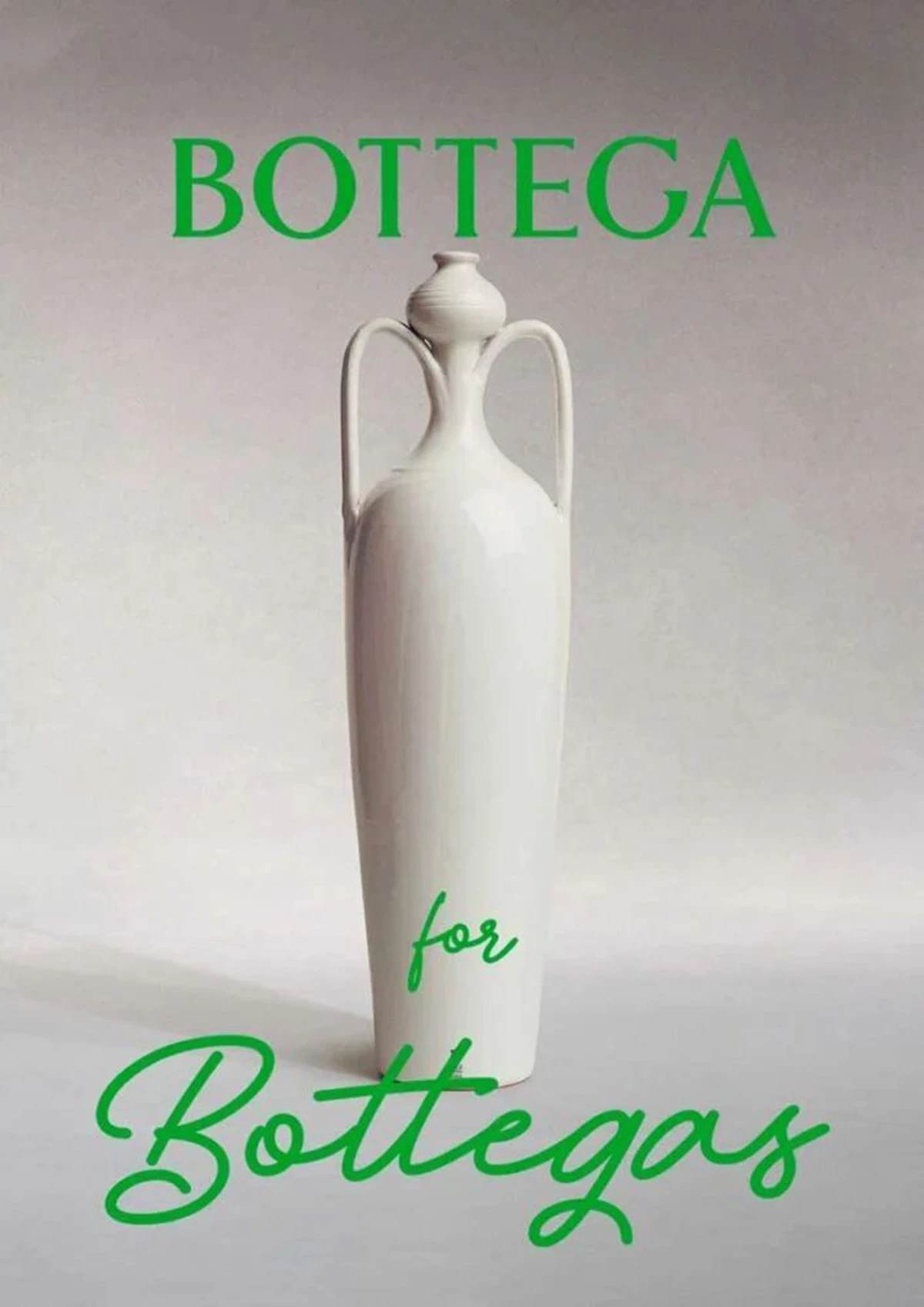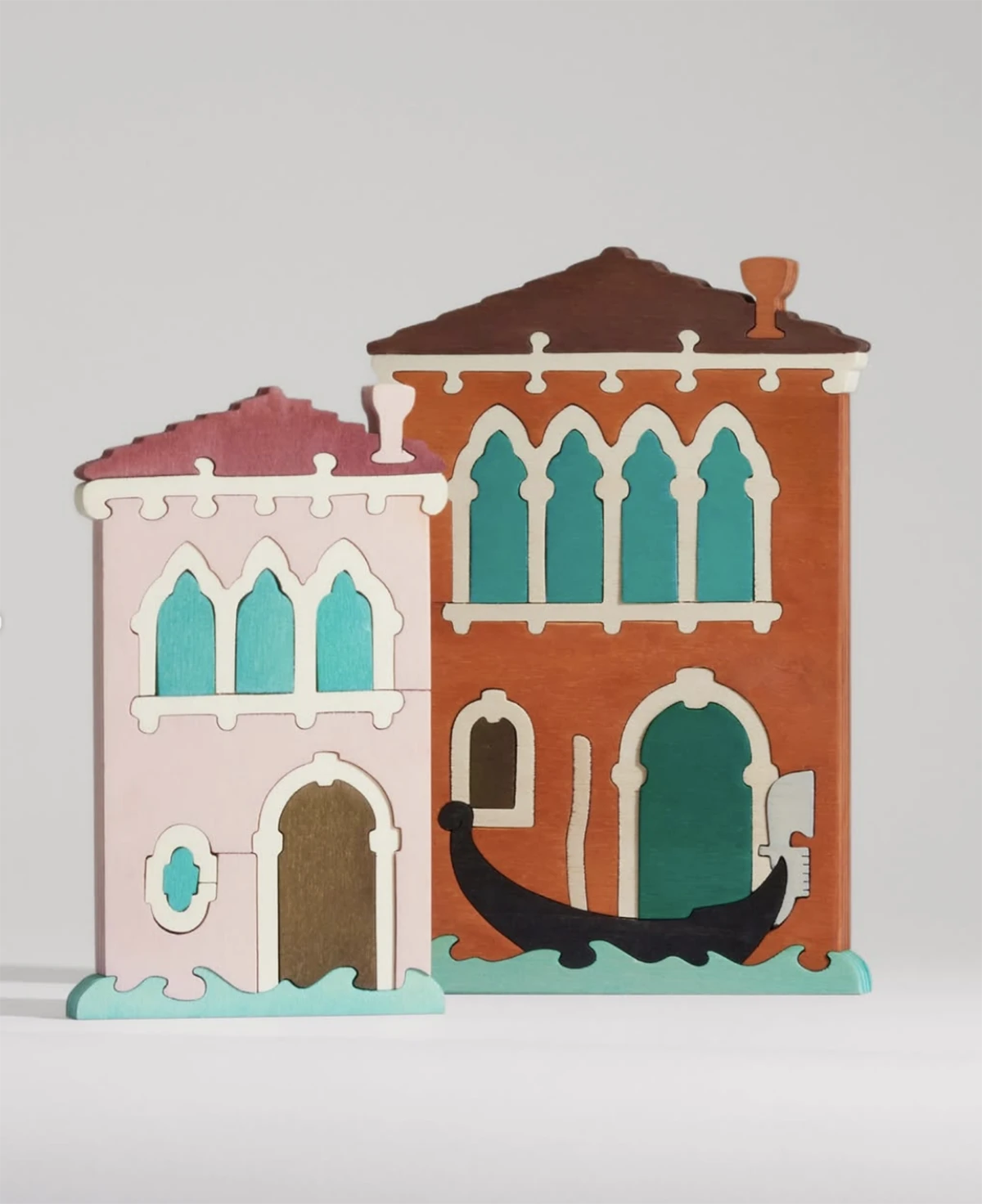
Fashion collaborations beyond fashion: Bottega for Bottegas
The fourth edition of the Bottega for Bottegas project explores the Venetian roots of the Maison and its woven legacy, featuring six artisanal ventures in dialogue with Lampoon
For the preservation of Italian botteghe, rough traces of humanity
We need botteghe. We need to go back to frequenting them, to wanting more of them, to see new ones open. These are contained spaces, repositories of creation. Imperfection, waste, callused hands, rough tools, graceful actions, knowing eyes, trained minds, raw materials. A bottega is a trace of humanity.
The semantics around the word bottega branch out into multiple meanings, beginning with the Greek maternal root ἀποϑήκη (apothéke), whose offspring generate many shades of sense—ranging from the chemist’s pharmacy in centuries past to an artist’s studio in the Renaissance, to the grocer in a small town, the tailor, the carpenter, the shoemaker.
Life unfolds in a bottega and passes through it. Neurotic deadlines bow to unceasing quality. “It’s not done yet, come back tomorrow.” It’s a daily workout for limbs, joints, neurons. A call to patience, training in choice and research. Evolving recipes of meticulous manual craftsmanship.

The Bottega Veneta initiative Bottega for Bottegas continues its annual renewal
It amazes with the unexpected pairings that a fashion brand can foster—ethical connections that underscore one of fashion’s key qualities: its transversal, shape-shifting nature made of intersections, crossovers, and alliances—even with those who work in a bottega.
Bottega for Bottegas: a project that explores the concept of craftsmanship, starting with the Italian tradition.
Conceived in 2021, Bottega for Bottegas was created to support local artisanal businesses affected by the economic repercussions of the pandemic. After initially involving Italian botteghe, in 2022 the project broadened its horizons to an international landscape, and the following year focused on four specific nations—Taiwan, China, South Korea, and Italy.
Over the years, the project has introduced objets d’affection that vary from Rockledge Farm Woodwork’s (Vermont) ice cream spoon, to the pasta measuring tool from Japanese workshop Price; from Florence-based ATELIERGK, specializing in bookbinding and restoration, to Less Panettone, founded by pastry chefs Gabriele Riva (Italy) and Kanako Sakakura (Japan), all the way to the wines of Azienda Agricola Sciara, a Sicilian winery founded by the Chinese sommelier Stef Yim. The common thread is Italian savoir-faire, the skill that lies in handcrafting—the detail that comes from hours of labor steeped in symbolism and stories, the dedication of those who pass on historic artisanal expertise, along with all the allure of imperfection—a trace of humanity.
It is a specific take on the concept of craftsmanship that delves into the uniqueness tied to each genius loci, where creations come to life through the diligence of professionals who embody traditions and the broader socio-cultural environment to which they belong.
The new edition of Bottega for Bottegas celebrates Bottega Veneta’s Venetian origins and handmade craftsmanship
In an era ruled by frenzied industrial production and fast fashion, it’s necessary to slow down and shine a light where unique skills lie hidden. Bottega Veneta is a guide in discovering fragile realities that guard beauty. It celebrates a sense of gratitude toward those who patiently create excellence with their hands and with passion—qualities deserving protection, perpetuation, and narration.
“Founded in Veneto in 1966, Bottega Veneta is influenced by Venice: its materials, motifs, craftsmanship, and its unique history of intercultural encounters. With this year’s edition of Bottega for Bottegas, we pay homage to the city’s contemporary artisans, whose mastery and dedication innovate and energize centuries-old artisanal traditions, from woodworking to glassblowing,” says Leo Rongone, CEO of Bottega Veneta, introducing this new endeavor dedicated to promoting handmade craftsmanship.
The six creations for the fourth edition of Bottega for Bottegas: tributes to Venetian culture
A selection of objects highlighting the raw materials from which they are made—ranging from metal alloys to glass and wood. Throughout December, Bottega Veneta’s communications—website, advertising spaces, newsletters, and window displays—are focused on Fonderia Valese’s brass pieces, a wooden puzzle by Signor Blum, a deck of playing cards in a leather case by Modiano, and glass creations by Laguna~B, Bruno Amadi, and Wave Glass. All of these entities reflect the Maison’s passion for artisanal innovation.
Bottega – a cultural anchor in the Italian tradition
Whether we’re talking about glasses, chandeliers, playing cards, shoes, handbags, furniture, statues, frames, or cheese and cured meats, this is where the unrepeatable happens. Technical reproducibility doesn’t cross the threshold. Every bottega has a distinct smell—glue, copaiba, pigment, turmeric, aged pecorino cheese, wood—and a soundtrack—glass being fired and shaped, knives, hammers, scissors, fabric becoming upholstery, paintbrushes brushing against canvas grain. These are artisanal anchors. The quintessence of hand craftsmanship. Antidotes to serial production. A bottega is where nothing changes so that nothing identical is ever made. We need botteghe. They are cultural outposts in Italy, accessible from the street level.
Lampoon in conversation with the artisanal ventures selected for Bottega for Bottegas
Modiano. Lampoon in dialogue with President Stefano Crechici
For the second consecutive year, Modiano is participating in Bottega for Bottegas. Founded in 1868, the Trieste-based company specializes in designing and producing playing cards, tarot decks, and other paper goods that have fostered an intergenerational fascination over time.
According to Stefano Crechici, President of Modiano,
“From its beginnings, Modiano has positioned itself as an industrial enterprise, initially specializing in the production and sale of cigarette papers, as well as in the printing of art lithographs and advertising posters. Even today we maintain an artisanal approach supported by cutting-edge machinery; these systems require specific expertise to be operated and calibrated for the production of a particular type of playing card. The so-called ‘machine setup’ can take our skilled workers up to eight hours. There’s no school you can attend to learn the knowledge needed in this company: training always happens internally. We hold technical-artisanal knowledge that’s hard to find elsewhere.”
Crechici continues, “In 2023, together with Bottega Veneta, we created two poker decks—old-style French suits—one in green shades and the other in yellow. Specifically, the front of each Ace was personalized with various elements representing some of the artisan’s tools: the Ace of Spades features a drawing of pliers; Diamonds, an awl; Clubs, a hammer; and Hearts, scissors. For this edition of Bottega for Bottegas, we paid homage to one of the Italian regional decks, the Venetian deck: it’s a set of cards that directly reflects a local identity and a socio-cultural background that expresses itself through the game and even the dialectal name it carries.”

Roberto Beltrami: from physics in Boston to founding Wave Murano Glass
Thirty-four-year-old Brescia native Roberto Beltrami fell in love with glass art during a visit to an exhibition in Boston. He left his physics career to move to Murano and learn the craft. In 2017, he founded Wave Murano Glass, a company of 20 professionals under the age of 35—a new generation of artisans.
Regarding his involvement in the Bottega for Bottegas project, Beltrami says, “We’re not a multinational but a small artisanal reality. Bottega Veneta was able to understand and promote our identity, offering us an exclusive platform. We are the youngest furnace on the island of Murano, open to the public free of charge during working hours and available for classes where one can learn glassmaking. We seek to blend tradition with digital and scientific progress, so as to increasingly carry this art into the future.”

Fonderia Artistica Valese: natural materials for creating models over 300 years old
Founded in 1913 by Luigi Valese, Fonderia Artistica Valese is the last remaining foundry in Venice. Today it’s run by Carlo Semenzato and upholds the traditional process of producing objects in brass and bronze using sand casting. Its creations feature classical Venetian motifs, along with decorative elements such as door handles and chandeliers.
Carlo Semenzato explains, “We use the most classic method, which involves using Terra di Francia (French sand), a natural material composed of a clay portion containing iron oxide. Using the positive—that is, the model—we create the negative by pressing it into this material with brown hues tending toward light yellow. This sand is held in frames, and the molten metal is poured through a hole to fill the impression, taking on the desired shape. We have designs and models inherited over centuries, some more than 300 years old. For the most recent ones, we rely on advanced technologies like 3D printing.”

Laguna~B: a contemporary language for handmade objects, according to Marcantonio Brandolini
Marcantonio Brandolini has been the creative director of Laguna~B since 2016:
“We have always felt close to Bottega Veneta’s communication. We favor a shared cultural language, as well as a strong connection to art and culture. It’s a non-nostalgic but contemporary language that sets the tradition of handmade craftsmanship in the present. The carafe selected by Bottega Veneta is part of the classic creations safeguarded in our archives.”
LagunaB is a Venetian company founded by Marie Brandolini in 1994. In collaboration with expert glass masters in Murano’s furnaces, LagunaB has revolutionized contemporary glassmaking with an innovative and experimental approach to production, models, and forms.
In a previous conversation with Lampoon, Brandolini said, “Our work is handmade and made to order. This is optimal because we can use technology to gauge the volumes requested by consumers. That way, you don’t force people to buy; rather, you try to understand what they actually need. Producing items without knowing their demand compels you to sell everything you’ve made, wearing out creative resources. Working on a made-to-order basis curbs overproduction, a hallmark of fast fashion but also of the broader contemporary market. Throughout our thirty years of activity, we’ve amassed a great many samples and such a vast archive that there’s no need to look elsewhere for inspiration. Creativity is something intuitive that can also be expressed by skillfully selecting from an archive. In modern and postmodern times, creativity must leverage catalogs to build upon.”

Signor Blum and woodworking
Founded in 1978, Signor Blum is a Venetian workshop specializing in sculptural wooden puzzles. Now run by second-generation owners—Guido Engelke, Matteo De Rossi, and Luca Palmieri—the workshop’s creations include architectural and characteristic elements of Venice, as well as animals, dinosaurs, boats, birds, and trees. Every single puzzle piece is designed, cut, and colored by hand.

Bruno Amadi and lampworked blown glass
Since 1974, Bruno Amadi has fashioned natural forms in glass at his workshop in Campo San Polo, Venice. He’s been handling glass from an early age and worked for several furnaces before opening his own studio. From starfish to butterflies, vegetables to lizards, his colorful creations blend technical skill with innovative methods and a meticulous observation of nature.

Bottega Veneta for Venice: objects that reflect the beauty of the fragile lagoon ecosystem
Meant to enhance Veneto’s cultural heritage, these objects are characterized by designs rich in historical significance. They radiate the spirit of Venice, a material extension of a lagoon-inspired sensibility that Bottega Veneta has increasingly embraced by choosing Palazzo Soranzo Van Axel as its cultural hub in Venice. It’s a fragile ecosystem, just like the art it safeguards.
Signor Blum’s block-puzzle is a reproduction of quintessential lagoon architecture; Modiano’s playing cards feature the Trevigiano deck, also known as the “Venetian” or “Veneto” deck, widely used in the Veneto and Friuli-Venezia Giulia regions for games like Scopa and Briscola; Fonderia Artistica Valese’s brass pieces depict the Lion of Saint Mark—Venice’s winged symbol dating back to the 12th century—as well as the gondola’s fero, whose wavy form recalls the sinuous Grand Canal. It symbolizes the three main islands of the lagoon—Murano, Burano, and Torcello—and its six sestieri (districts), represented by the prongs, and the Rialto Bridge.
Bottega Veneta and Venetian glassmaking: from collectible objects to perfume bottles
The multi-colored striped vase by Laguna~B, the star by Bruno Amadi, and the flower by Wave Murano Glass continue the Venetian glassmaking tradition that sprang from Roman and Byzantine knowledge. As early as 982 AD, a notarial deed documents the existence of an artisan who practiced the trade of fiolario, manufacturing blown hollow glass—bottles known in Venetian as fiole.
The malleability and variegated patterns of Murano glass are rooted in the tradition of Italian handcraft, reflecting that artisanal flair that over time has given life to designs by Vittorio Toso Borella, Tapio Wirkkala, and Carlo Scarpa, among others. These are cult and collectible objects that, despite their fragility, emit both experimentation and technical precision.
Bottega Veneta is once again celebrating the inspiration it derives from the Venetian imagination, following the recent presentation of its first olfactory collection under Matthieu Blazy—today Creative Director of Chanel—who took inspiration from blown glass architecture and aesthetics for the fragrance bottle design.
The history of perfume is in fact linked to Venice, a historic epicenter for the trade and creation of fragrances by muschieri (old Venetian perfumers). This tradition is celebrated in the halls of the Museo di Palazzo Mocenigo—Center for the Study of the History of Textiles, Costume, and Perfume—which houses an exact copy of the Notandissimi secreti de l’arte profumatoria, written by Giovanventura Rosetti in Venice in 1555. This work is considered the first Western book entirely devoted to perfume and its creation.
Bottega Veneta’s commitment to ethical and sustainable luxury
Remaining true to its founding in Vicenza during the experimental 1960s—specifically, 1966—Bottega Veneta continues to uphold the core pillars of Labor et Ingenium—the name of the Academy created to train a new generation of artisans.
Today, the Montebello Vicentino Atelier is located at Villa Schroeder-Da Porto, surrounded by a 55,000-square-meter park protected by Italian environmental agencies. An example of ethical commitment to social as well as ecological sustainability, the Montebello Atelier was also celebrated in the fashion film Craft in Motion (April 2023). Extending Blazy’s creative approach, Craft in Motion was directed by Massimiliano Bomba and narrated by one of Bottega Veneta’s long-time artisans, Ruggero Negretto.







